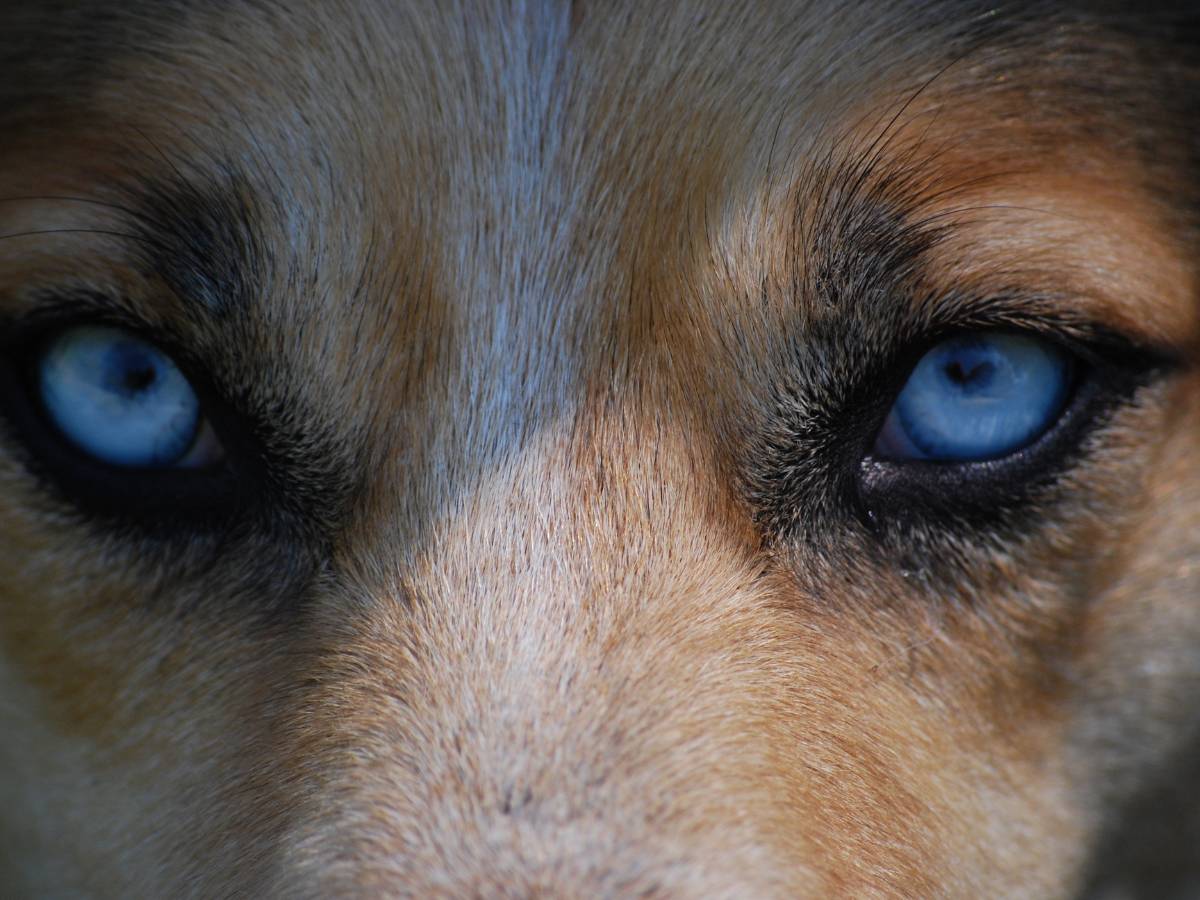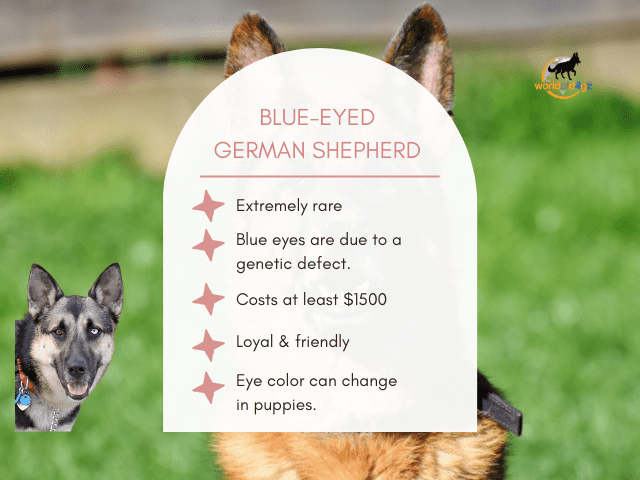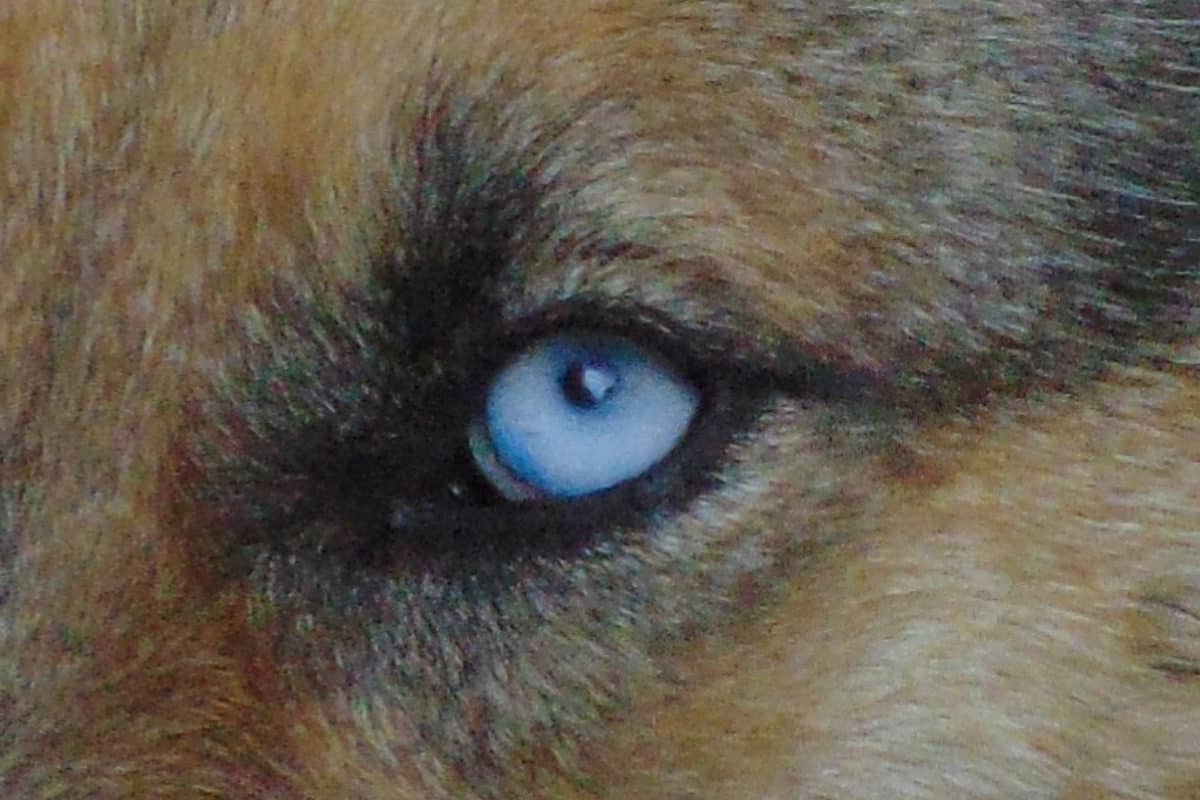As an experienced German Shepherd owner, I’ve navigated the vast seas of information and misinformation surrounding our beloved breed. One topic that often surfaces, sparking curiosity and debate, is the occurrence of blue eyes in German Shepherds.
It’s a subject shrouded in mystery and fascination. You might have seen those captivating images circulating online, showcasing German Shepherds with striking blue eyes, and wondered, “Is this real? Can German Shepherds have blue eyes?”
German Shepherds can have blue eyes, but it is extremely rare. This trait is not standard for the breed and often results from genetic variations or crossbreeding with other breeds that carry the blue eye gene. Purebred German Shepherds with blue eyes may not meet the breed’s standard criteria set by kennel clubs.
In this exploration, we’ll dive deep into the genetics, myths, and truths about blue-eyed German Shepherds.
Whether you’re considering adding a German Shepherd to your family, you’re simply intrigued by this rare trait or wonder if your blue-eyed dog is purebred, understanding the facts will illuminate your knowledge and appreciation of the breed.
Key Takeaways:
- Blue-eyed German Shepherds are extremely rare. This unusual eye color can result from genetic variations or crossbreeding.
- The presence of blue eyes does not affect the health or temperament of the German Shepherd.
- Prospective owners should prioritize health and temperament over eye color when selecting a German Shepherd.

Rare Sight: The Story Behind Blue-Eyed German Shepherds
A German Shepherd can have blue eyes due to a genetic defect that causes one or both eyes to be a different color.
Their piercingly blue eyes have little to no effect on their temperament, so you can expect the same characteristics as a typical German Shepherd.
Learn About The Blue-Eyed GSD In Our Video…
Let’s take a quick look at dog coat color genetics to understand how German Shepherds predominantly get blue eyes. Don’t worry, nothing too heavy!
The genetic site that causes the blue color is the D (dilute) locus. The diluted pigment lightens coats from black to blue. It causes, in effect, a watered-down version of black.
D (dominant full color) and d (recessive dilute) are the two alleles connected with dilution. It takes two recessive alleles (dd) to lighten black pigment to blue.
Simply put, both parents must carry and pass on the recessive D gene for a German Shepherd to have blue eyes. It is, therefore, impossible for a blue-colored dog to have any black on its coat.
While these dogs are beautiful, the American Kennel Club classifies their eyes as an issue, docking points or refusing to let them rank in conformation.
So, although blue-eyed German Shepherds can enter events, they are seldom seen. This causes controversy among owners of blue GSDs, who often feel discriminated against.

Unraveling the Genetics
A German Shepherd with blue eyes is extremely rare because both parents must carry the recessive D locus gene, home to the dilution gene.
A black dog becomes blue when a dog is homozygous for dilute. So, it is highly uncommon to get two mutated copies of the gene that causes blue eyes.
While many dog breeds can also lose pigmentation in their eyes to make them look blue, a German Shepherd can have truly blue eyes, albeit unique.
There’s no exact percentage or number of how many GSDs have blue eyes, but the trait is exceedingly uncommon. Nonetheless, this genetic rarity doesn’t come with health side effects outside the norm.
Learn More on How The Dilute Locus Lightens Coats From Black to Blue…
Are German Shepherds With Blue Eyes Purebred?
German Shepherds with blue eyes can be purebred or mixed. This trait is much more common if mixed with a husky since these dogs can naturally have blue eyes.
However, a purebred German Shepherd can have light brown, dark brown, golden, hazel, or blue eyes without another breed in the mix.
If you’re worried about whether or not your GSD is purebred, the Embark Dog DNA Test Kit from Amazon is the best way to find out. Send a quick sample and determine if your pup is mixed or if his blue eyes are a purebred genetic rarity.
- DISCOVER YOUR PUPS RELATIVES: Find and connect with your pups family through the world’s first canine relative finder; Nearly one million messages exchanged for countless happy reunions
- SUPPORTS DOG HEALTH AND WELFARE: Embark is partnered with Cornell University College of Veterinary Medicine and other researchers; Each test purchased contributes to finding and treating genetic disease in dogs; Purchases also support Embarks Old Dogs, New Homes initiative which helps find new families for older dogs in shelters
- FAMILY TREE & SIMILAR DOGS: You can see your dogs family tree all the way back to great-grandparents; Unlike other tests, Embark can even identify breeds in mixed-breed great-grandparents, perfect for the muttiest mutts; Embark also shows other dogs of similar breed mix to your pup; You can explore their profiles and photos and even send messages to their humans over the Embark site to compare your dogs quir
Prices pulled from the Amazon Product Advertising API on:
Product prices and availability are accurate as of the date/time indicated and are subject to change. Any price and availability information displayed on [relevant Amazon Site(s), as applicable] at the time of purchase will apply to the purchase of this product.
Note: Clicking the above link(s) will take you to Amazon or an online store where we have an affiliate relationship. If you make a purchase, we may earn a commission at no additional cost to you.
The Blue German Shepherd Dog
Blue-eyed German Shepherd dogs, also known as Blue German Shepherds, are stunning in appearance. All GSDs have striking features, but adding blue eyes makes them even more beautiful.
Below, you’ll learn all about their characteristics and potential health issues.
Hey! If you’d like to take a quick glance at a blue-eyed GSD, here’s a crisp poster.

Temperament and Personality
Blue German Shepherds are loyal to a fault, much like their brown-eyed relatives. Many German Shepherds can develop anxiety if their owner isn’t around enough.
They need lots of attention, so getting a Blue GSD is best if you have several hours at home with them.
Blue-eyed German Shepherds can also be quite confident and brave. When raised in the right household, these dogs will feel proud of themselves and their territory.
They can be guard dogs but won’t shy away from cuddling on the couch or playing fetch in the backyard.
Common Health Problems
German Shepherds with blue eyes are prone to hip dysplasia, osteoarthritis, and digestive issues as they age.
All of these health concerns can be minimized or managed with the three following tips:
- Healthy food is crucial from birth through their senior years.
- German Shepherds need up to two hours of exercise daily.
- Attention and affection prevent the anxiety that can cause stress, seizures, and blood pressure problems.
Another quick tip is to assist your blue-eyed German Shepherd if he’s jumping up or down from a high surface, such as a truck bed, swimming pool, or deck, as this helps to protect his joints.
I also recommend you invest in a good orthopedic bed suitable for large breeds as they help prevent mobility issues and ease pain and discomfort caused by arthritis.
Check out this article, 5 Best Orthopedic Dog Beds for German Shepherds.
Are Blue Eyes in GSDs a Health Concern?
Some owners might be concerned that blue eyes in a German Shepherd cause additional health concerns. But are blue eyes in the German Shepherd breed a health concern?
Blue eyes in German Shepherds aren’t a health concern because they don’t cause any detrimental effects on the dog.
These lovely dogs are just as healthy as the standard brown-eyed German Shepherds. Their health predictability is based on their genetics, diet, activity, and affection.
There’s no need to worry about your German Shepherd’s blue eyes having a long-term effect on their health. It won’t impact their sight, hearing, energy levels, or anything else.
So, what causes the confusion?
Some dogs, such as the Australian Shepherd, Border Collie, and Great Dane, carry the M-locus Merle gene that causes mottled white patches of fur, solid or piebald, on the face and body.
The Merle gene can also cause blue eyes in these breeds, and when two Merle carriers breed, the resulting litter (known as “double merle”) is at a substantially higher risk of being deaf, blind, or both.
Breeding two Merle gene carriers is expressly forbidden and deemed inhumane.

Understanding the Cost of a German Shepherd with Blue Eyes
A German Shepherd with blue eyes costs at least $1,500, depending on the breeder, their ancestors, the location, and many other factors.
Blue eyes typically don’t increase the price since they’re not always prized by the breeders, sadly. However, this presents an opportunity to bring a gorgeous pup into your home.
But…
You may be able to find rescue dogs (including Blue German Shepherds) for as little as $100. It’s up to you to decide if you want a puppy from a breeder or a dog in desperate need of a home.
Where to Buy This Blue-Eyed Beauty
To buy a blue-eyed German Shepherd, you’ll have to talk to local breeders. It’s impossible for a breeder to intentionally have blue eyes GSDs, though they could breed two of them to attempt to make more with the same condition.
Again, blue eyes are a genetic defect, which means they’re unpredictable and difficult to produce. They should be seen as rare gems rather than defective dogs, though!
You can also watch local animal shelters, pounds, and online marketplaces to find these blue-eyed beauties.
FAQs
Do German Shepherd puppies’ eyes change color?
German Shepherd puppies’ eyes will change color at around three to four weeks old. All puppies open their eyes between days 8 and 14 when they will be blue-gray due to a lack of melanin. Over the next two weeks, their eyes will gradually change color, usually brown.
What color should a German Shepherd’s eyes be?
A German Shepherd’s eye color should be as dark as possible according to the American Kennel Club breed standard. Most German Shepherds’ eyes are, therefore, brown. The exact shade of brown depends on the amount of melanin that gives the eyes pigmentation.
Can a blue-eyed German Shepherd participate in dog shows?
According to most breed standards, blue eyes are considered a fault in German Shepherds, potentially disqualifying them from conformation shows.
What are the grooming needs of a blue-eyed German Shepherd?
Blue-eyed German Shepherds have the same grooming needs as their dark-eyed counterparts, requiring regular brushing, nail trimming, and ear cleaning to maintain their health and coat condition.
Related Posts You May Like:






